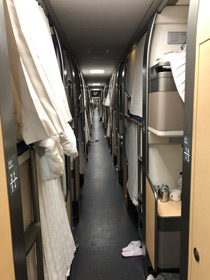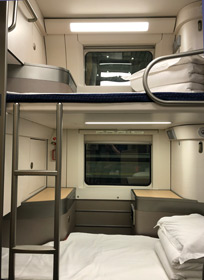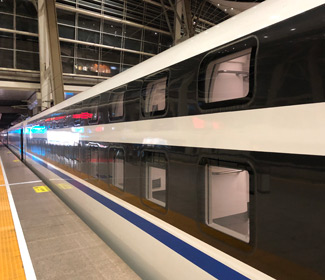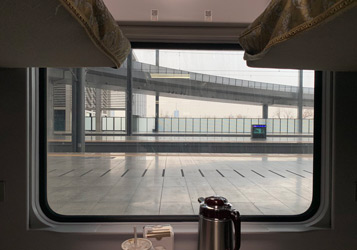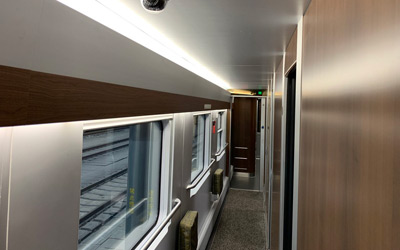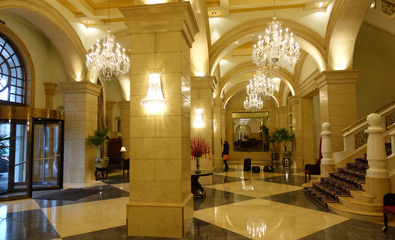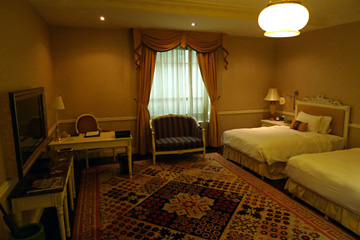| |
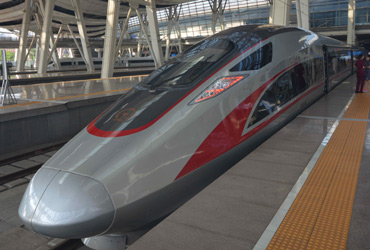 |
| |
Beijing to
Shanghai by 350 km/h (217 mph) high-speed
train. Or save time & a hotel bill by sleeper train.

For other Chinese train routes & a beginner's guide to train travel in China,
see the main China page... |
Beijing to Shanghai by train or flight?
Between Beijing & Shanghai, the
train is the way to go. Choose between the World's Fastest Passenger
Train, a 350 km/h (217 mph) high-speed
train taking as little as 4h18 or a time-effective 250 km/h (156 mph) express
sleeper train which saves a hotel bill. Either way, it's a unique Chinese
experience. When you consider the time taken to get to & from remote
airports, airport check-in & security plus the unreliability of domestic flights
on the overcrowded Beijing-Shanghai corridor, the clean & punctual high-speed
train is as quick as flying and much more fun. This page will show you
what the trains are like, advise you on which class to travel in, and how to buy
your ticket online or in person.
 Beijing to Shanghai southbound train times
Beijing to Shanghai southbound train times
 Shanghai to Beijing northbound train times
Shanghai to Beijing northbound train times
 How much does it cost?
How much does it cost?
 How to buy tickets
How to buy tickets
 What are the G-category high-speed
trains like?
What are the G-category high-speed
trains like?
 What are the D-category
sleeper
trains like?
What are the D-category
sleeper
trains like?
 Quick guide to boarding at Beijing South
Quick guide to boarding at Beijing South
 Quick guide to boarding at Shanghai Hongqiao
Quick guide to boarding at Shanghai Hongqiao
 Hotel suggestions in Beijing & Shanghai
Hotel suggestions in Beijing & Shanghai
Beijing
► Shanghai by high-speed train
|
|
Train number: |
G103 |
G1 |
G105 |
G107 |
G3 |
G111 |
G113 |
G5 |
G117 |
G119 |
G7 |
G121 |
G123 |
G125 |
|
Beijing South
station
depart |
06:20 |
07:00 |
07:17 |
07:25 |
08:00 |
08:16 |
08:39 |
09:00 |
09:20 |
09:24 |
10:00 |
10:05 |
10:14 |
10:48 |
|
Shanghai Hongqiao
arrive |
11:58 |
| |
13:03 |
13:12 |
| |
14:11 |
15:01 |
13:37 |
14:55 |
15:32 |
14:35 |
15:42 |
16:26 |
16:50 |
|
Shanghai main station |
- |
11:29 |
- |
- |
12:32 |
- |
- |
- |
- |
- |
- |
- |
- |
- |
Beijing
► Shanghai by high-speed train, continued...
|
|
Train number: |
G9 |
G127 |
G129 |
G131 |
G133 |
G11 |
G135 |
G137 |
G13 |
G139 |
G141 |
G15 |
G143 |
G145 |
|
Beijing South
station
depart |
11:00 |
11:05 |
11:18 |
11:27 |
11:49 |
12:00 |
12:12 |
12:47 |
13:00 |
13:04 |
13:34 |
14:00 |
14:08 |
14:14 |
|
Shanghai Hongqiao
arrive |
15:37 |
17:08 |
17:38 |
17:22 |
18:02 |
16:38 |
18:21 |
18:56 |
| |
19:06 |
20:08 |
18:33 |
20:07 |
20:12 |
|
Shanghai main station |
- |
- |
- |
- |
- |
- |
- |
- |
17:35 |
- |
- |
- |
- |
- |
Beijing ► Shanghai by
high-speed train, continued...
|
|
Train number: |
G147 |
G17 |
G149 |
G151 |
G19 |
G153 |
G157 |
G21 |
G159 |
G161 |
G23 |
G25 |
G27 |
|
Beijing South
station
depart |
14:27 |
15:00 |
15:08 |
15:49 |
16:00 |
16:30 |
16:53 |
17:00 |
17:19 |
17:33 |
18:00 |
18:04 |
19:00 |
|
Shanghai Hongqiao
arrive |
20:43 |
19:34 |
21:10 |
22:12 |
20:28 |
22:27 |
23:13 |
21:18 |
23:18 |
23:32 |
| |
22:58 |
| |
|
Shanghai main station |
- |
- |
- |
- |
- |
- |
- |
- |
- |
- |
22:43 |
|
23:29 |
Beijing ► Shanghai by sleeper train
|
|
Train number: |
T109 |
D9 |
D5 |
|
Beijing main
station
depart, day 1: |
20:03 |
- |
21:21 |
|
Beijing Nan (South)
station
depart, day 1: |
| |
19:36 |
| |
|
Shanghai main station
arrive day 2: |
11:02 |
07:46 |
09:27 |
All trains shown here run every day,
check times for your date of travel online
as shown here. A few extra trains run on Fridays, Saturdays,
Sundays.
G-category 300 km/h
or 350 km/h high-speed
trains have
2nd, 1st & Business class seats,
see the photos &
advice here & watch the video guide.
D-category
250 km/h
express sleeper trains
have soft sleepers & 2nd class seats, some may have hard sleepers,
see photos & advice.
Z-category classic sleeper train
Z281/Z282 has soft & hard sleepers, soft & hard seats,
see info & advice.
T-category
classic sleeper train T109/T110 has soft & hard sleepers and hard class seats,
see info & advice.
Finding & boarding your train
Luggage arrangements
Hotels in Beijing
Hotels in Shanghai
Beijing metro map.
Shanghai metro map.
Map of Beijing showing stations.
Map of Shanghai showing stations
Which station in Beijing?
Almost all
Beijing-Shanghai trains now use
Beijing South Station (Beijing Nan), 6km southwest of central Beijing.
One or two trains still use Beijing's main central
station, normally written as plain Beijing.
Which station in Shanghai?
Most
Beijing-Shanghai trains now use Shanghai's new
Hongqiao station, 18 km
from central Shanghai near the old airport.
One or two D & T category sleeper trains still use Shanghai's more central main station (Shanghai Zhan)
which is actually in the city centre. One or two high-speed G trains also
use Shanghai main station as shown above.
Distances: Beijing
South to Shanghai Hongqiao via the new high-speed line is 1,318 km (819 miles),
a little shorter than the classic route, which is 1,454 km (909 miles) from
Beijing railway Station to Shanghai station. The new high-speed line
opened in 2011.
Route map:
There's an excellent interactive map at
cnrail.geogv.org/enus/route/CN~G0001 which you can search by station or
train number. I've set up that link to show the route taken by
Beijing-Shanghai high-speed train G1.
Check current times for all trains at
www.chinahighlights.com or any of the Chinese
train timetable websites listed here.
Shanghai
►
Beijing by high-speed train
|
|
Train number: |
G104 |
G102 |
G2 |
G106 |
G108 |
G110 |
G6 |
G112 |
G114 |
G8 |
G116 |
G118 |
G10 |
G122 |
|
Shanghai main station |
- |
- |
07:00 |
- |
- |
- |
- |
- |
- |
- |
- |
- |
- |
- |
|
Shanghai Hongqiao
depart |
06:27 |
06:37 |
| |
07:22 |
07:22 |
07:38 |
08:00 |
08:05 |
08:15 |
09:00 |
09:26 |
09:43 |
10:00 |
10:26 |
|
Beijing
South station arrive |
13:12 |
12:38 |
11:36 |
13:22 |
13:22 |
13:32 |
12:24 |
14:07 |
14:12 |
13:27 |
15:22 |
15:47 |
14:26 |
16:08
|
Shanghai
►
Beijing by high-speed train, continued...
|
|
Train number: |
G122 |
G124 |
G12 |
G128 |
G14 |
G130 |
G132 |
G134 |
G16 |
G138 |
G140 |
G18 |
G142 |
G144 |
|
Shanghai main station |
- |
- |
- |
11:15 |
11:53 |
- |
- |
- |
12:55 |
- |
- |
- |
- |
- |
|
Shanghai Hongqiao
depart |
10:34 |
10:44 |
11:00 |
| |
| |
12:16 |
12:21 |
12:26 |
| |
13:29 |
13:34 |
14:00 |
14:16 |
14:43 |
|
Beijing
South station arrive |
16:29 |
16:43 |
15:31 |
17:22 |
16:38 |
18:21 |
18:25 |
18:44 |
17:36 |
19:31 |
19:42 |
18:35 |
20:10 |
20:45 |
Shanghai
►
Beijing by high-speed train, continued...
|
|
Train number: |
G20 |
G146 |
G148 |
G22 |
G150 |
G152 |
G24 |
G154 |
G156 |
G158 |
G160 |
G162 |
G26 |
G28 |
|
Shanghai main station |
- |
- |
- |
- |
- |
- |
- |
- |
- |
- |
- |
- |
17:55 |
- |
|
Shanghai Hongqiao
depart |
15:00 |
15:21 |
15:25 |
16:00 |
16:04 |
16:19 |
17:00 |
17:11 |
17:16 |
17:20 |
17:41 |
17:46 |
| |
19:00 |
|
Beijing
South station arrive |
19:36 |
21:05 |
21:42 |
20:37 |
21:56 |
22:20 |
21:33 |
22:49 |
23:08 |
23:14 |
23:42 |
23:51 |
22:35 |
23:18 |
Shanghai
►
Beijing by sleeper train
|
|
Train number: |
T110 |
D8 |
D6 |
D10 |
|
Shanghai main station
depart |
16:30 |
19:08 |
21:15 |
21:21 |
|
Shanghai South station depart |
| |
| |
| |
| |
|
Beijing
South station arrive |
| |
| |
| |
09:24 |
|
Beijing
main station arrive |
08:32 |
07:14 |
09:26 |
- |
All trains shown here run every day,
check exact times for your date of travel online
as shown here. A few extra trains run on Fridays, Saturdays,
Sundays.
Finding & boarding your train
Luggage arrangements
Hotels in Beijing
Hotels in Shanghai
Beijing metro map.
Shanghai metro map.
Map of Beijing showing stations.
Map of Shanghai showing stations
Fares for
high-speed trains
|
|
One-way per person |
By G-category 300 km/h train |
|
2nd class seat |
1st class seat |
Business class seat |
|
Beijing-Shanghai, bought in
China: |
RMB 553
|
RMB 933 |
RMB 1,748 |
|
Beijing-Shanghai,
booked online: |
USD 93
|
USD 149 |
USD 325 |
Fares for
sleeper trains
|
|
One-way per person,
approx |
D-category fast sleeper train |
T-category sleeper train |
|
Hard sleeper
|
Soft sleeper |
Hard sleeper |
Soft sleeper |
|
Beijing-Shanghai, bought in
China: |
RMB ? |
RMB 615 |
RMB 305 |
RMB 477 |
|
Beijing-Shanghai,
booked online: |
USD 84 |
USD 102 |
USD 46 |
USD 70 |
$1 = approx RMB 7. £1 =
approx RMB 8.9.
Children: As
of 1 January 2023, children
under 6 travel free (just one per adult goes free), all other children under 14
travel for half
fare. Those 14 & over pay full fare. Child discounts only apply to the 'base'
part of a sleeper fare, so in sleepers it's closer to a 25% reduction on the
total fare.
The sleeper
fares shown here are for lower berths. Upper berths
(and middle berths in hard sleeper) are a fraction cheaper.
|
|
 |
|
|
|
-
Option 1, buy tickets in either direction
at
www.chinahighlights.com, a reliable agency that I can recommend.
They can book all classes.
-
Option 2,
buy tickets in either direction
at
12go.asia, another reliable booking agency.
Confirmation is instant. You are emailed an
e-ticket for your mobile phone with which you can board the train.
-
Option 3, buy tickets at
www.trip.com,
another well-known and reliable agency.
-
Travel is now ticketless, you
scan your passport at the automatic gates at the entrance to the platform, the
system recognises your passport number, knows you have a reservation and lets
you through, see the
section below about finding & boarding your train.
-
For a full run-down of the
various ways to buy Chinese train tickets in person and online,
see the
how to buy tickets section on the Train Travel in China page.
-
Tip: After booking, if you
find a self service ticket machine of the latest type which recognises passports
as well as Chinese ID cards, you can use it to print out a reminder of your
itinerary with car & seat numbers, and/or after your journey use one to print an
old-style ticket (now merely a reimbursement slip) as a souvenir,
see the
self-service ticket machine section on the China page.
Buying tickets at the station: See
advice here
-
It's fairly easy to buy
tickets in person at the station even if you don't speak Chinese,
see how to
buy tickets at the station.
-
Trains in China are always
busy and often leave fully-booked, but on the Beijing-Shanghai route there
are many trains with thousands of seats, and it's usually possible
to find a ticket of some sort even for travel tomorrow, even if not today -
at least outside peak
holiday times.
-
Availability
displays at stations show which trains have seats left in which class on
which of the next few days. Just be prepared to take a second choice of
train or date or class.
Two different types of train
operate the G-category high-speed trains between Beijing and Shanghai, Fuxing
meaning revival and Heixe meaning harmony. If your train has a
single-digit or 2-digit
train number (for example G1 or G15) and a
Beijing-Shanghai journey time of 4h18-4h43, then it will be a 350
km/h CR400
Fuxing. If it has a 3-digit train number (for example G117 or G120) &
journey time over 5h it is likely to be a 300 km/h CRH380 Heixe.
See tips for travel by high-speed
train about luggage, seat numbering, food, WiFi...
Fuxing (revival) trains CR400A &
CR400B
The fastest G-category services
are operated by Fuxing (revival) trains. These are the world's fastest passenger trains, designed for up to
400 km/h and operating in service at up to 350 km/h (217 mph). There are
two designs, the red & grey CR400A (pictured below left) or the white & gold
CR400B (below right), but the interiors are the same. Each design comes in
an 8-car & 16-car version, and offers 2nd class, 1st class & business class plus
a small cafe counter selling Chinese tea, coffee, beer, snacks & microwaved hot
dishes. Unlike the Heixe trains there are no sit-down cafe tables,
just the serving counter.
 |
|
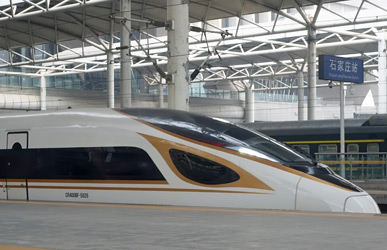 |
|
A CR400A Fuxing at Beijing
South, courtesy of Brett Cubit. |
|
A CRH400B
Fuxing. Fuxing means revival. |
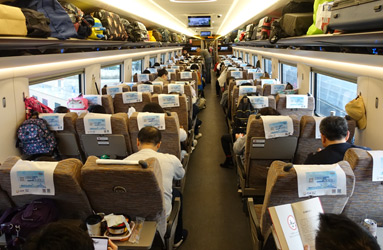 |
|
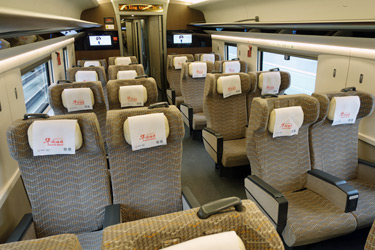 |
|
2nd class seats
are arranged 2+3 across the car width. Perfectly OK if you're on a
budget, but not much space per person, especially if you get a middle
seat.
Larger photo. |
|
1st class seats
are far more spacious, arranged 2+2 across the car width.
There's a power socket for each pair of seats in the seat base. Well
worth the extra cost.
Larger photo. |
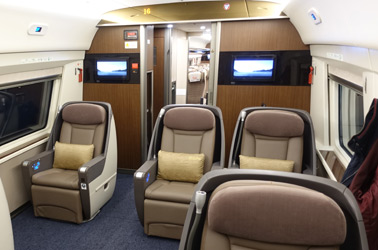 |
|
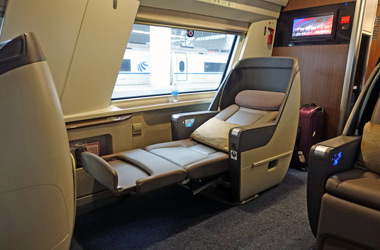 |
|
Business class seats
are arranged 1+2 across the car width, in a spacious carpeted car and on a
Fuxing there is also a small business class area with 5 seats at the end of the
train, seen here. The
seats recline electrically and become a flat bed at the touch of
a button. Each seat has a power socket. Business class is expensive even by western standards, but if
you can stretch that far it's well worth it. The fare includes one hot
tray meal and a constant stream of tea, coffee, apple juice, orange juice or
soft drinks. There's a VIP lounge for
business class passengers at Beijing South & Shanghai Hongqiao. Business class is expensive
even by western standards, but if you can stretch that far it's well worth it.
Click the images for larger photos. |
Heixe (harmony) trains CRH400A &
CRH400B
Other G-category trains are
operated by Heixe (harmony) trains, which also come in two designs, the Chinese-designed
CRH380A and the
German-designed
CRH380B.
Both types are designed for speeds up to 380 km/h and operate at up
to 300 km/h (186 mph) in service. They have the same classes as Fuxing trains,
although the colour scheme is different.
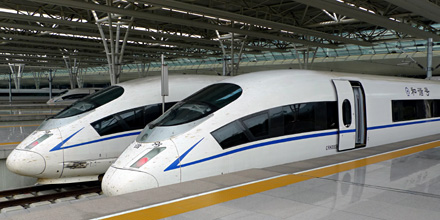 |
|
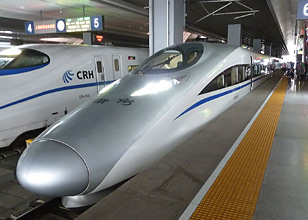 |
|
CRH380B... German-designed by Siemens, you can see the similarity to a German
Railways ICE3 train. There is an
8-car & 16-car version. |
|
CRH380A... These are
Chinese-designed 300km/h trains with 8-car &
16-car versions. |
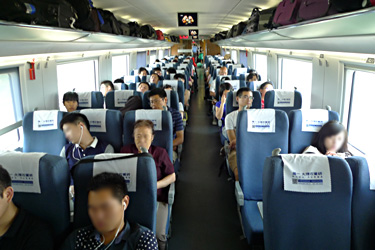 |
|
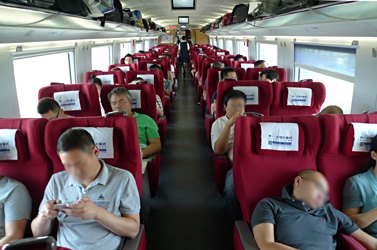 |
|
2nd class seats
on a CRH380B, arranged 2+3 across the car width. May not be power sockets. |
|
1st class seats
arranged 2+2 across the car width. There is a power socket for each pair
of seats, in the seat base. |
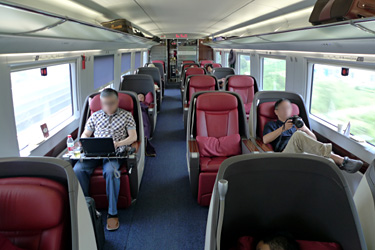 |
|
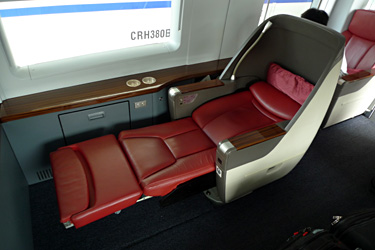 |
|
Business class seats
on a CRH380B. On a 16-car CRH380 you'll find one whole car of business
class seats plus two business class seats in the very end compartment at each
end of the train. |
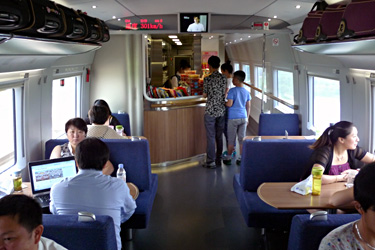 |
|
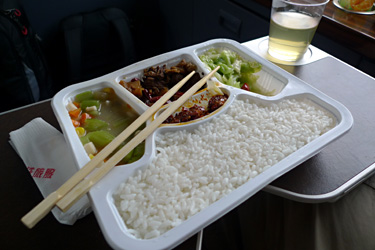 |
|
Buffet car on a CRH380B with
counter & tables selling snacks, beer, soft
drinks... |
|
A complimentary meal
with plenty of green tea & orange juice are served in business class. |
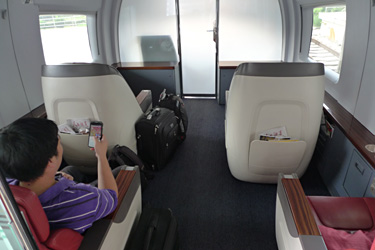 |
|
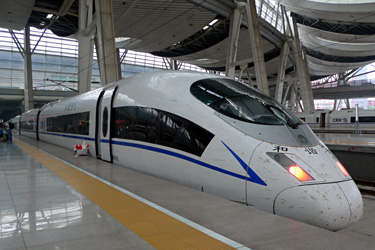 |
|
The sightseeing area on a
CRH380B, immediately behind the cab at each end of the train. On CRH380
Heixe trains the sightseeing area is arranged like this, with
two business class seats behind the cab, then a row of three
narrower non-reclining seats which are sold as first class. On some
routes and trains the sightseeing areas are fitted with six
first-class-style seats which are sold as superior (or premium
or deluxe, the English translation varies).
The Man in Seat 61 says:
"As you can see, the glass to the cab is permanently electrically
frosted up, so there's not much sightseeing going on (the term 'sightseeing' has
officially now been dropped). This cab was
at the rear of the train, so the seats faced backwards, whereas most
other seats on the train are turned round to face forwards before the
train boarded. I'd stick with seats in the regular first or business class cars." |
-
Seat numbering
Seats are numbered with a row
number then a seat letter, like on a plane. In 2nd class where seats are
3+2 across the car width the seat letters are ABC-aisle-DF. In 1st class
with 2+2 seating the seat letters are AC-aisle-DF. In business class
the seat letters are AC-aisle-F except for the pair of seats behind the driver's
cab at each end of the train which are lettered A-aisle-F. So in all classes, A & F are
always window seats. C & D are always aisle seats. B is the
undesirable middle seat of three in 2nd class.
Car 1 is normally at the
front from Beijing to Shanghai, and at the back from Shanghai to Beijing.
Car 8 or 16 is at the other end.
Luggage
You take
your bags onto the train with you, max 20 Kg per adult, 10Kg per child, maximum
length in any one dimension 130cm, although in practice no-one weighs or
measures anything. It goes on the racks above your seat or (larger items)
the luggage stacks at the end of each car near the entrance doors.
Food & drink
You can take food & drink
with you, or buy simple microwaved tray meals, snacks & drinks (including
beer) from the buffet counter. The buffet accepts RMB but not
HK$. Have some cash with you, don't reckon on it accepting cards.
Heixe trains have a buffet counter and seats around tables which you
can use freely, a nice place to socialise away from your seat.
Fuxing trains just have the counter, no tables.
On a Fuxing you'll find the buffet counter in car 5 on 8-car trains,
car 9 on 16-car trains.
Business class tickets include a hot tray meal and a steady flow
of complimentary tea, coffee & soft drinks plus a 'welcome box' of various
Chinese sweets.
There's a
boiling water dispenser in each car - ideal for making noodles, tea or
coffee if you bring the necessary materials along!
Power sockets and WiFi
On Fuxing trains, all
seats have power sockets & USB ports. On Heixe trains, all first & business class seats have power sockets,
but not all 2nd class
seats do. In theory all these trains have free WiFi, but
this requires a code to be sent to a Chinese mobile phone so foreign
visitors cannot use it. Just sign up for a mobile data package from
your phone provider, there is good 3G/4G reception along most of this route.
Using mobile data on a foreign SIM card also gets around China blocking
access to Google, Facebook, Twitter and so on, but you might want to pay for
a VPN to get around these restrictions when on WiFi,
see more information here.
Watch the video: Shanghai
to Beijing by high-speed train
CRH2E high-speed sleeper trains
These modern express sleeper trains can travel at up to 250km/h (156 mph),
although in this case they use the classic route and won't exceed 160km/h (100
mph). The CRH2E trains are 16-cars long,
consisting of 13 sleeping-cars each with nine comfortable 4-berth soft sleeper
compartments, one buffet car and two streamlined end cars with a limited number
of 2nd class seats.
The soft sleepers
have very welcome powerful air-conditioning and there's a power socket for laptops,
mobiles & cameras under the table. Pillows, sheets & fluffy duvet
are provided. The door locks securely, with a security-latch to
prevent the door opening more than an inch even if the regular lock is
undone from outside with a staff key. Each berth even has a small
TV screen, although these did not work on this occasion. Toilets &
washroom are just along the corridor.
The Man in Seat 61 says: "This is a modern and comfortable train.
Have a Tsingtao beer or two in the buffet, then retire to your sleeper berth,
Shanghai tomorrow morning! Sharing a 4-berth sleeper is no problem,
whatever your western sensibilities. When the photos below were taken we
shared with a pleasant Chinese lady in her late 20s who spoke good English, and
a young man who spent most of the evening on his laptop."
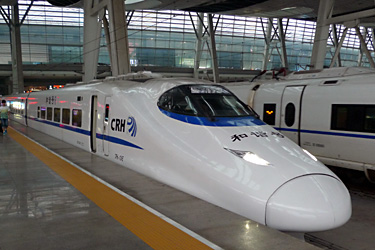 |
|
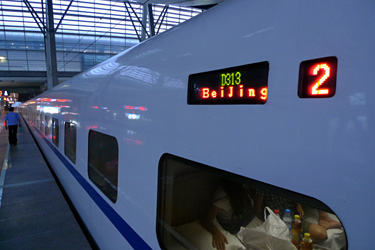 |
|
An express sleeper
train to Shanghai waits to leave Beijing South. |
|
The trainside displays
clearly state train number, origin-destination & car number. This
is car 2. |
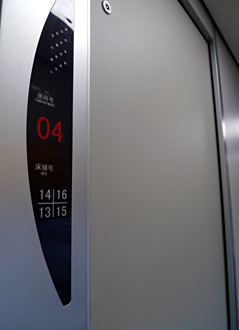 |
|
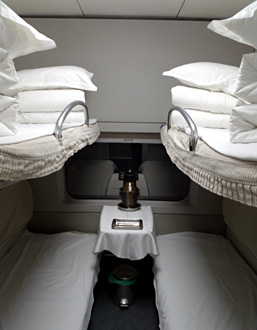 |
|
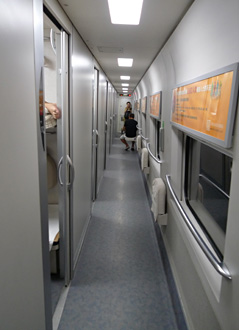 |
|
Berths are clearly numbered on
the compartment door. |
|
The train has comfortable 4-berth
soft sleepers. |
|
The sleeper corridor is fairly
wide, with tip-up seats. |
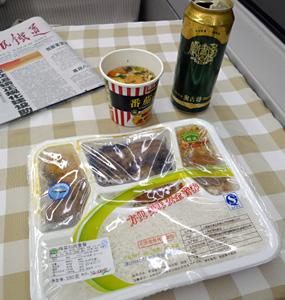 |
|
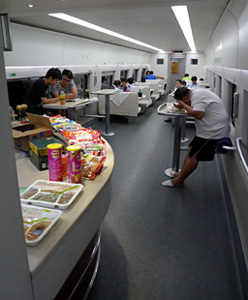 |
|
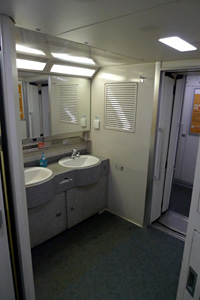 |
|
Buffet car with counter &
tables in the centre of the train, selling snacks, beer (RMB 15), soft drinks
and microwaved tray meals like this for around RMB 40 (£4, $6). |
|
Washroom area at
the end of each car. |
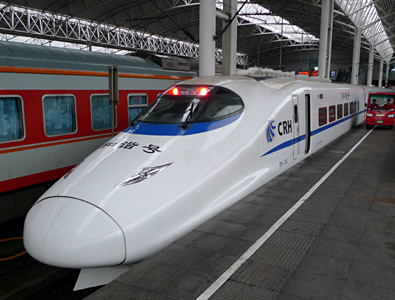 |
|
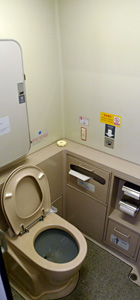 |
|
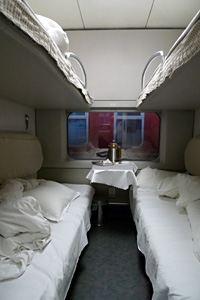 |
|
The D313 express sleeper from
Beijing, arrived at Shanghai, right on time. These D sleeper trains use
Shanghai's more central main station, not Hongqiao. |
|
The train has both
western & Asian-style toilets, with toilet paper & paper towels provided. There's also a baby-changing table. |
A new type of sleeper
was deployed on some Beijing-Shanghai D-category night trains in 2017. Instead of conventional 4-berth soft sleeper compartments the
new train has open-plan upper & lower berths arranged longitudinally along the
car walls, with an upper and lower row of windows for upper and lower berths,
see this
video. Each berth has its own individual curtains for privacy.
On some booking sites
this type is
described as capsule sleeper. However, it's probably no
longer operating on this route now the
Revival Green trains are being delivered.
Yet another type of fast sleeper train has now been deployed on the Beijing-Shanghai
route from 2019, the CR200J Revival Green. Painted in a rather
bright green
livery, these are 16-car sleeper trains designed for up to 200 km/h mainly on the classic network,
but also on some high-speed lines.
They have 7 soft sleeper cars, each of which has ten lockable 4-berth soft sleeper
compartments, 6 hard sleeper cars with bunks in doorless compartments of 6,
several 2nd
class seats cars and a buffet counter in car 9 serving snacks and drinks
including beer. If a D-category train is shown online as having hard sleepers, it's a
CR200J Revival Green.
 |
|
A CR200J Revival Green sleeper
train. Photos in this section are courtesy of David Feng... |
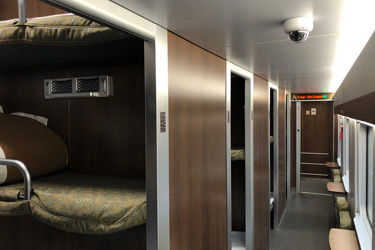 |
|
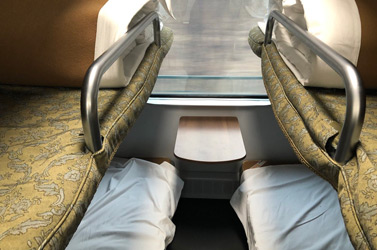 |
|
Hard sleepers on a CR200J,
in doorless compartments of 6 berths, two lower, two middle, two upper.
Fresh clean sheets, duvet and pillow are supplied. There are small tables
& tip-up seats in the corridor for evening or morning use. There are
toilets (both normal & squat type) and a set of washbasins at the end of the
corridor. |
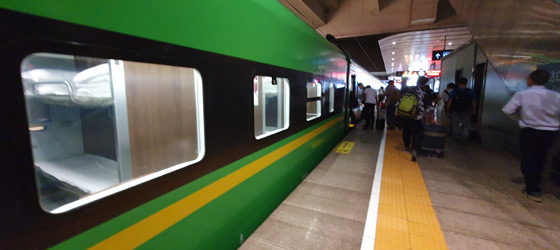 |
|
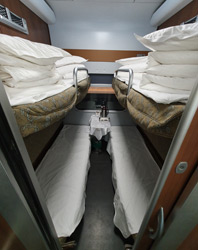 |
|
Soft sleepers on a CR200J,
in lockable compartments of 4 berths, two lower & two upper. There's a
table under the window, and each berth comes with an individual berth light &
USB power sockets. Fresh clean sheets, duvet and pillow are supplied.
There are toilets (both normal & squat type) and a set of washbasins at the end
of the corridor. Luggage goes in your compartment, under the lower berth
or on the floor.
See larger soft
sleeper photo. |
Watch the video: Beijing to
Shanghai by high-speed sleeper train
How to reach Beijing South
Station: Beijing South station (BeijingNan) is
6 km (4 miles) south-southeast of Tiananmen Square. You can travel there easily & cheaply by
Beijing Subway (see
Beijing subway map) for just RMB 5 (60p, $0.75), allow 40 minutes for the
subway journey. Or you can take a taxi, the taxi fare from central Beijing to
Beijing South is around RMB 35 (£3.50, $6), allow at least 30 minutes for
the taxi ride.
There's a brief X-ray baggage check as you enter
the station, so arrive at least 30 minutes before your train leaves... If you arrive by taxi, it will drop you at the
taxi rank alongside the vast main departures hall (pictured above right). You walk into the
departures hall and immediately queue for a brief luggage X-ray check,
followed by a 'wanding' by security staff. If you arrive by metro,
you emerge from the metro platforms into the downstairs arrivals level, and
must take escalators or lifts up to the main departures hall, passing
through a luggage X-ray check and security staff 'wand' search to enter the
hall. If you walk in through the ground-level main entrance you
immediately pass through a luggage X-ray check, then go up a long tall
escalator into the main departures hall where (you've guessed it) there's
yet another luggage X-ray check and security staff 'wand' search to enter
the hall. Although these simple security checks are nothing like what
you have to go through at an airport, you should arrive at least 30 minutes
before your train leaves, assuming you have already collected your tickets.
Finding your train is easy... Large electronic departures boards
clearly show the train number, destination, departure time and ticket
gate number, see the photos below. The board alternates between English & Chinese. Go to the
ticket gate shown, a display at the gate confirms that you're in the right
place. Boarding usually starts 30 minutes before departure, your
ticket & passport are checked at the gate before you go down the escalators to the platform.
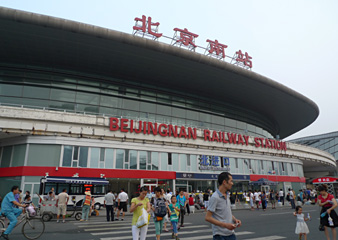 |
|
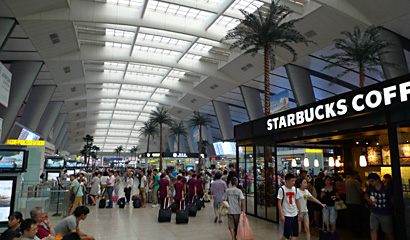 |
|
Beijing South main entrance. |
|
The departures hall, upper level
above the tracks. |
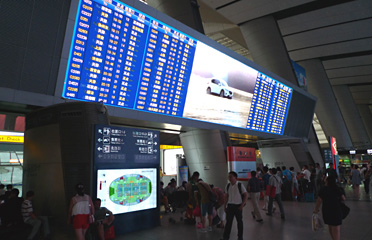 |
|
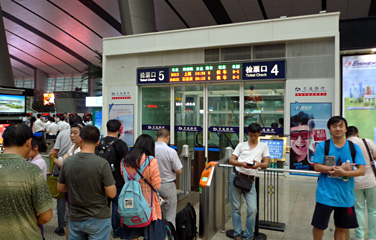 |
|
One of the main departure boards. |
|
The ticket gate for platforms 4 &
5. |
How to get to Shanghai
Hongqiao: Honqiao railway station is
18km (11 miles) west of central Shanghai. You can travel there easily & cheaply by
Shanghai metro (see
Shanghai metro map) for just RMB 5 (60p, $0.75), allow 40 minutes for the
metro journey. Or you can take a taxi, the taxi fare from central Shanghai is around RMB
40 (£4, $7), allow at least 30 minutes for the taxi ride.
X-ray baggage check:
If you arrive by taxi, you arrive outside the main departures hall and
there's a simple X-ray baggage check and 'wanding' by security staff
when you enter the hall. If you arrive by metro, you emerge from
the metro at the arrivals level
downstairs, follow the signs up the escalators to the departures hall, with
a simple X-ray baggage check and 'wanding' by security staff before you
enter the hall.
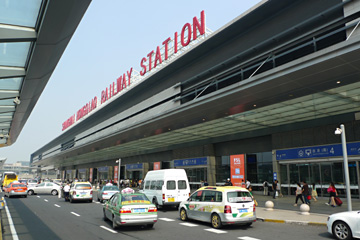 |
|
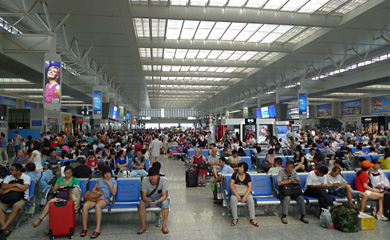 |
|
Shanghai Hongqiao station & taxi
rank. |
|
Shanghai Hongqiao departure hall. |
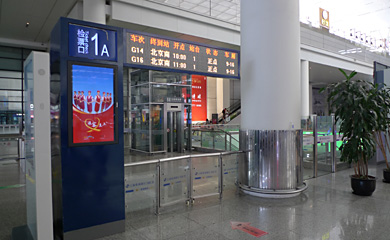 |
|
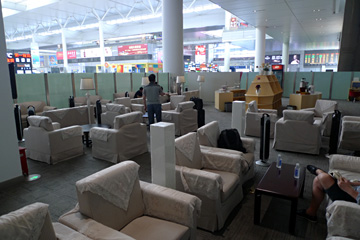 |
|
Ticket gate 1, for the 10:00 G14 to
Beijing. |
|
Business Class lounge
in the
main hall near gate 1. It offers complimentary tea, coffee &
snacks. |
The Beijing Hotel Nuo Forbidden City dates from 1917, making it one of the oldest hotels
in Beijing, see
http://en.wikipedia.org/wiki/Beijing_Hotel. It's just a few minutes walk along the main
road to Tiananmen Square and the entrance to the Forbidden City, 3 minutes walk
from Wanfujing Metro Station. Service is
excellent and the colonial-style rooms spacious. An extensive breakfast buffet is served in the modern
extension behind the main building. The hotel was originally Block B of
the Beijing Hotel, Block C next door dating from 1954 is now the Beijing Grand
Hotel and Block D dating from 1974 retains the name Beijing Hotel and is a
state-run hotel. Tip: The hotel's rooms are both in the original
1917 block and the modern block behind, ask for a room in the original 1917
building.
A cheaper option, still
with good reviews and reasonable location, try the
Pentahotel Beijing. It's informal, comfortable, and walking distance
from Beijing Railway station - although you're better off taking a taxi if you
have luggage.
There's a bar and noodle bar downstairs.
The Fairmont Peace Hotel is the place if you have a generous budget (€190+
for a double) and want
history and grandeur with 5-star comfort, located right in the centre of the
Bund in a classic building which dates from 1929. Originally the Cathay
Hotel, pre-1949 it was regarded as Shanghai's most prestigious hotel. The
relief murals in the lobby remind me of New York's Empire State or Chrysler
Buildings! There's more information on its history at
en.wikipedia.org/wiki/Peace_Hotel.
Back to home
page

![]() Beijing to Shanghai southbound train times
Beijing to Shanghai southbound train times![]() Shanghai to Beijing northbound train times
Shanghai to Beijing northbound train times![]() What are the G-category high-speed
trains like?
What are the G-category high-speed
trains like? ![]() What are the D-category
sleeper
trains like?
What are the D-category
sleeper
trains like?![]() Quick guide to boarding at Beijing South
Quick guide to boarding at Beijing South![]() Quick guide to boarding at Shanghai Hongqiao
Quick guide to boarding at Shanghai Hongqiao![]() Hotel suggestions in Beijing & Shanghai
Hotel suggestions in Beijing & Shanghai




























